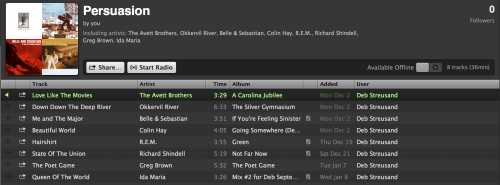You are here
Teaching Rhetorical Pathos through Playlists
Primary tabs

Deb Streusand -- Screenshot of Spotify
A fun way to teach students the power of rhetorical pathos using multiple media. Students create Spotify playlists to accompany a short persuasive essay on a topic of their choice.
- Computers are required, but the lesson plan could be adapted for a non-computer classroom if students are able to bring in laptops.
- Headphones are also required for the students to listen to the playlists.
This lesson plan can be used to teach rhetorical pathos through the making of playlists. It was created for a computer-enabled classroom, but could also work for a conventional classroom if students were able to bring in laptops.
Students must first acquire accounts on Spotify.com, a free music streaming service. This can be done at the previous class meeting, or, with instructions, as part of homework.
To prepare for this class, students write short persuasive essays on a topic of their choice and create Spotify playlists to accompany them, with the purpose of inducing emotions that will help persuade the reader to agree with the writer of the essay.
In class, the students listen to the playlists. One could combine any activity that wasn't overly distracting with listening to the music. I let them listen while doing whatever they would typically do on the computer while they listen to music -- allowing Facebook, Twitter, etc. This activity provides a sort of neutral starting point for the students as the playlist works on them, while alleviating the boredom that might come with solely listening to the music. Next, the students read their partner's persuasive essay. They then write a brief response describing how the playlist made them feel and how the essay used those emotions to persuade them. They email this response to the partner and the professor.
For homework, the students revise their persuasive essays to incorporate more emotional language, playing on the same feelings as the playlist songs.
Students enjoy making and listening to the playlists, and they also absorb the idea of inducing emotion in an audience as a persuasive tactic.
Ahead of time:
- Become familiar with Spotify, so as to be able to answer student questions about how to use it.
In the class before the pathos activity:
- Allow students 5-10 minutes in class to acquire Spotify accounts, or in, a non-computer classroom where they will bring laptops the next time, send them home with instructions on how to do so.
- Assign the following homework:
- Write a one-page persuasive essay on a topic of your choice.
- Make a fifteen-minute Spotify playlist intended to induce feelings that will make a partner agree with your opinion on the topic.
In class:
- Allow students 15 minutes to listen to the Spotify playlists.
- Allow students about 45 minutes to read and respond to their partner's essay.
- Assign students to revise the essay for homework, using language that plays on the same emotions the partners mentioned as effective in their responses.
Joining Spotify:
- Go to https://www.spotify.com/us/signup/
- Fill in the information to create a free account
- Click on "Sign Up" at the bottom of the page.
Homework to prepare for this lesson:
- Write a one-page persuasive essay on a topic of your choice.
- Make a fifteen-minute Spotify playlist intended to induce feelings that will make a partner agree with your opinion on the topic. Think about things like the tempo of the music, the content of the lyrics, the instrumentation. How do you want the music to affect your partner?
- Bring your headphones with you to class next time.
- [Non-computer classroom] Bring your laptop with you to class next time.
In class:
- Listen to your partner's Spotify playlist. During this time, you may do whatever you normally do on the computer whie listening to music.
- After you are finished listening to the playlist, read your partner's essay. Think about how you felt listening to the playlist and consider how it affects the way you read the essay.
- Write a response to your partner's essay, detailing how the playlist made you feel and how it affected your reading of the essay. Consider what emotions were or were not effective in persuading you. Give your partner feedback on this so that they know what emotions to use in revising the persuasive essay. This is not the place to critique their opinion; your job is to help them argue more effectively.
Homework:
- Revise your persuasive essay to incorporate emotional language as part of your persuasive technique. Consider the feedback your partner gave you about the emotions your playlist evoked and how they did or did not help persuade your partner to agree with you.
I did not evaluate this assignment, because the grade percentages on my syllabus did not include points for in-class assignments or homework, but only major writing assignments. In a course where homework counted for points, I would probably give a completion grade and feedback on the revised essays.
Students enjoyed making and listening to the playlists. They seemed to absorb the idea of using emotion to persuade, but sometimes struggled to incorporate the feelings evoked by the musical media into their text. If I were teaching this lesson again, I would spend part of the preceding lesson analyzing how one or two texts used pathos. That way, students could have a better understanding of how pathos operates in texts before trying to use it themselves.
-

- Log in to post comments

